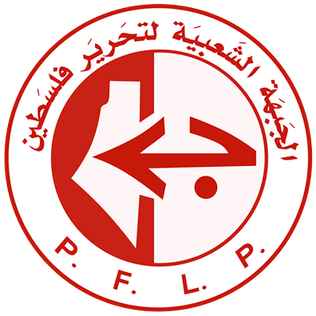
Aircraft hijacking is the unlawful seizure of an aircraft by an individual or a group. Dating from the earliest of hijackings, most cases involve the pilot being forced to fly according to the hijacker's demands. There have also been incidents where the hijackers have overpowered the flight crew, made unauthorized entry into the cockpit and flown them into buildings – most notably in the September 11 attacks – and in several cases, planes have been hijacked by the official pilot or co-pilot; e.g., Ethiopian Airlines Flight 702.
The Japanese Red Army was a militant communist organization active from 1971 to 2001. It was designated a terrorist organization by Japan and the United States. The JRA was founded by Fusako Shigenobu and Tsuyoshi Okudaira in February 1971, and was most active in the 1970s and 1980s, operating mostly out of Lebanon with PFLP collaboration and funding from Muammar Gaddafi's Libya, as well as Syria and North Korea.

TWA Flight 847 was a regularly scheduled Trans World Airlines flight from Cairo to San Diego with en route stops in Athens, Rome, Boston, and Los Angeles. On the morning of June 14, 1985, Flight 847 was hijacked soon after take off from Athens. The hijackers demanded the release of 700 Shia Muslims from Israeli custody and took the plane repeatedly to Beirut and Algiers. Later Western analysis considered them members of the Hezbollah group, an allegation Hezbollah rejects.
In December 1973, a terrorist group executed a series of attacks originating at Rome-Fiumicino Airport in Italy which resulted in the deaths of 34 people. The attacks began with an airport-terminal invasion and hostage-taking, followed by the firebombing of a Pan Am aircraft and the hijacking of a Lufthansa flight.

Commandos is the special forces formation of the Singapore Army responsible for conducting special operations. Commandos are tasked with infiltrating behind enemy lines by raiding and reconnaissance operations using airborne raids, helicopter assault and sea landings. The formation is made up of only one battalion, the 1st Commando Battalion, and is based in Hendon Camp.
The following lists events that happened during 1974 in Singapore.
Counter-terrorism in Singapore is a series of detection and prevention measures to minimize the damage caused by terrorism. These measures involve the participation of all levels of society, including defence, internal security, border and infrastructure security, civil defense, and gives special focus on areas such as medical readiness and psychological preparedness.

While Japan's political mainstream has the CDP and the LDP as dominant forces, there is political extremism to the left and the right.

Wadie Haddad, also known as Abu Hani, was a Palestinian militant who led the combat operations of the Popular Front for the Liberation of Palestine. He was responsible for organizing several hijackings of international civilian passenger aircraft in the 1960s and 1970s, the most infamous of which was the Entebbe hijacking, when Palestinian/German militants under his command held 106 hostages — both Israelis and non-Israeli Jews — on a flight from Israel to France after diverting it to Uganda.
Pulau Bukom, also known as Pulau Bukum, is a small restricted-access island belonging to Singapore that is located about five kilometres to the south of Mainland Singapore, off the Straits of Singapore. The size of Pulau Bukom is about 1.45 km2 (0.56 sq mi).

The history of the Republic of Singapore began when Singapore was expelled from Malaysia and became an independent republic on 9 August 1965. After the separation, the fledgling nation had to become self-sufficient, however was faced with problems including mass unemployment, housing shortages and lack of land and natural resources such as petroleum. During Lee Kuan Yew's term as prime minister from 1959 to 1990, his government curbed unemployment, raised the standard of living and implemented a large-scale public housing programme. The country's economic infrastructure was developed, racial tension was eliminated and an independent national defence system was established. Singapore evolved from a third world nation to first world nation towards the end of the 20th century.

The Police Coast Guard (PCG) is a division of the Singapore Police Force that combines the functions of marine police and coast guard in Singapore. Its duties include the law enforcement and search and rescue operations in collaboration with the Maritime and Port Authority of Singapore and the Immigration and Checkpoints Authority. It is headquartered at Brani Regional Base on Pulau Brani.
Pulau Busing is a restricted-access island and a hub for oil shipping located off the southwestern coast of Singapore. The island is occupied by Tankstore Ltd, a petroleum storage company. Heavily industrialised, the island is home to oil and chemical storage facilities, at least one marine offshore terminal, and a fuel oil refinery.

Palestinian fedayeen are militants or guerrillas of a nationalist orientation from among the Palestinian people. Most Palestinians consider the fedayeen to be "freedom fighters", while most Israelis consider them to be "terrorists".
On 6 February 1974, Palestinian militants occupied the Japanese embassy in Kuwait City, taking the ambassador and ten others hostage. The militants' motive was to support the Japanese Red Army members and Palestinian militants who were holding hostages on a Singaporean ferry in what is known as the Laju incident. Ultimately, the hostages were released, and the guerrillas were allowed to fly to Aden.

The Mothers' Bus attack refers to the 1988 hijacking of an Israeli civilian bus carrying workers to the Negev Nuclear Research Center. Three Arab militants took 11 passengers hostage and executed two passengers. The bus was then stormed by Yamam, Israel's elite counter-terrorism unit. In the 40-second takeover operation, all three hijackers were killed, along with one of the hostages.
MV Dromus was a 1930s British oil tanker owned by Anglo-Saxon Petroleum, a British subsidiary of Royal Dutch Shell. She was launched in September 1938 by Harland and Wolff at Belfast in Northern Ireland. She was one of a class of 20 similar tankers built for Anglo-Saxon.

The Popular Front for the Liberation of Palestine (PFLP) is a secular Palestinian Marxist–Leninist and revolutionary socialist organization founded in 1967 by George Habash. It has consistently been the second-largest of the groups forming the Palestine Liberation Organization, the largest being Fatah.
On 13 and 19 January 1975, El Al aircraft at Paris-Orly Airport, France were subject to attempted RPG attacks by Popular Front for the Liberation of Palestine (PFLP) terrorists led by Carlos the Jackal. While the intended attacks failed, collateral damage was suffered and the second attack resulted in gunfighting and a seventeen-hour hostage situation.
The 1973 Hellinikon International Airport attack was an attack at the Hellinikon International Airport at Athens, Greece. The two attackers were members of the Palestinian militant organization Black September. The militants used sub-machine guns and grenades against the passengers waiting in the passenger lounge. The attackers took hostages before they finally surrendered to the Greek police. It is believed that the gunmen wanted to hijack a plane, but they decided to attack when they were about to be searched by a Greek security inspector before boarding.












